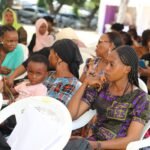Vertex Initiatives Collaborating with the government to establish a safe environment for the education of the girl child is crucial for promoting gender equality and ensuring that girls have equal access to education. Here are several ways in which such collaboration can take place:
- Advocacy for Policy Change:
- Work with government officials and policymakers to advocate for policies that promote and protect the right to education for girls.
- Advocate for the implementation and enforcement of laws that prevent discrimination, harassment, and violence against girls in educational settings.
- Community Engagement:
- Collaborate with local government bodies to engage communities in discussions about the importance of girls’ education.
- Organize community workshops and awareness campaigns to address cultural and societal norms that may hinder girls’ access to education.
- Infrastructure and Safety Measures:
- Collaborate with government agencies to improve school infrastructure, ensuring that schools are safe and welcoming environments for girls.
- Advocate for the implementation of safety measures such as well-lit pathways to schools, security personnel, and proper sanitation facilities.
- Training and Sensitization:
- Collaborate with the government to provide training for teachers, school staff, and local law enforcement on gender sensitivity and creating a safe and inclusive learning environment.
- Promote gender-sensitive curricula and teaching materials that challenge stereotypes and promote equality.
- Access to Resources:
- Advocate for government initiatives that provide financial assistance, scholarships, and other resources specifically targeted at supporting girls’ education.
- Collaborate on projects that provide essential resources such as textbooks, uniforms, and transportation to make attending school more feasible for girls.
- Monitoring and Reporting:
- Work with government agencies to establish monitoring mechanisms to track progress in girls’ education and to identify and address instances of discrimination or violence.
- Encourage the establishment of reporting systems that allow students, parents, and community members to report incidents of harassment or discrimination.
- Partnerships with NGOs and Civil Society:
- Collaborate with non-governmental organizations (NGOs) and civil society groups that focus on girls’ education to leverage collective expertise and resources.
- Share best practices and successful models for promoting girls’ education with government agencies.
- Research and Data Collection:
- Collaborate on research initiatives to collect and analyze data on girls’ access to education, dropout rates, and the impact of various interventions.
- Use research findings to inform evidence-based policy decisions and program implementations.
Through these collaborative efforts, governments and organizations can work together to create a conducive and safe environment for the education of the girl child, fostering empowerment and breaking down barriers to education.




